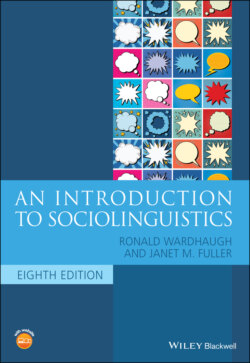Читать книгу An Introduction to Sociolinguistics - Ronald Wardhaugh, Janet M. Fuller - Страница 21
Variants and the linguistic variable
ОглавлениеWe discussed variants above, saying that variants are different forms which largely mean the same thing; we could also say that they are different forms which can be used in the same environment. A linguistic variable is a linguistic item which has identifiable variants. For instance, the variation between washroom, bathroom, toilet and loo gives us four lexical variants. Another example which has been studied extensively is the vowel system of US English (e.g., Gordon 2002), including, for example, the production of words such as cot and caught – some people pronounce these two words the same, while others use distinct vowels.
These examples show that there are at least two basically different kinds of variation. One is of the kind with distinct variants, such as different lexical items. The other kind of variation is a matter of degree; pronunciation of vowels is not binary but includes production on a continuum within the vowel space.
An important principle in the analysis of variants is the principle of accountability, which holds that if it is possible to define a variable as a closed set of variants, all of the variants (including non‐occurrence if relevant) must be counted. That is, the analysis is done by identifying all of the environments where the variable could occur, and then seeing which variants are used. Take, for example, the study of third person singular ‐s marking. Some speakers of English have variation between this marker and a null variant (e.g., she goes and she go may both be used). To study this, you would look at all contexts with a third person singular subject. While this principle applies to grammatical variables in general, for pragmatically motivated variables such as discourse markers (e.g., you know, well) the principle of accountability cannot be applied, as there are no mandatory environments for such particles. As we will see in Part II, the features of language studied is an important consideration when choosing a research methodology.
